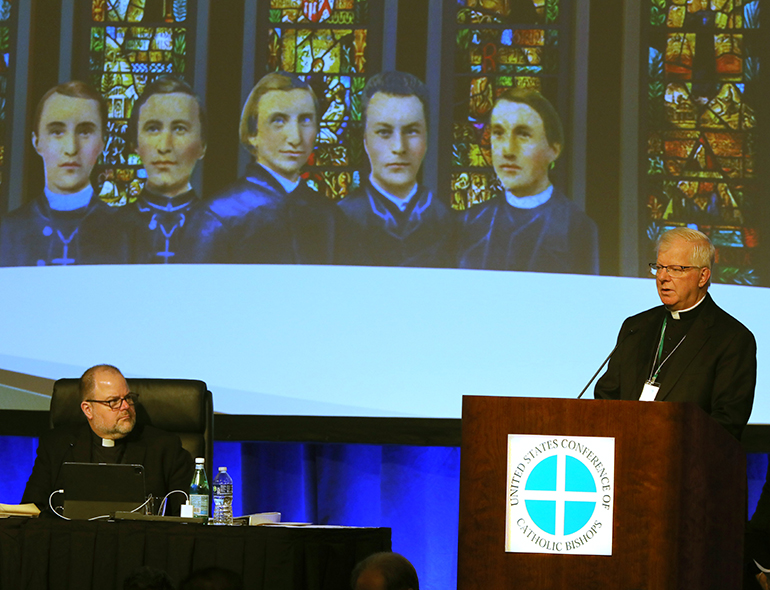ORLANDO, Florida (OSV News) | When five missionary priests of Brittany, France, volunteered to serve people suffering in Shreveport, Louisiana, they knew they were risking their lives.
Yet they sacrificed their own welfare during a pandemic to journey with the dying and bring the Eucharist to the faithful. Their names might not be familiar to the entire U.S. church, but those in northwest Louisiana know the men as the “Shreveport martyrs.”
“They demonstrated heroic charity during the third worst pandemic in U.S. history,” said Bishop Francis I. Malone of Shreveport, who added the priests’ example during the yellow fever epidemic of 1873 “resounds beyond the Catholic world,” as the men ministered to the sick regardless of religious affiliation.
“Even in dark times and in dark places, human beings are spiritual beings who sacrifice themselves for humankind for the common good,” he said.
Bishop Malone made those remarks June 15, 2023, during the U.S. bishops’ spring plenary assembly at the Omni Championsgate in the southern part of the Diocese of Orlando. He, along with Archbishop Jerome E. Listecki of Milwaukee, offered the consultation on the cause of the priests’ beatification and canonization.
Fathers Jean Pierre, Jean Marie Biler, François Le Vézouët, Isidore Quémerais and Louis Marie Gergaud were all young men, ages 26 to 27, Bishop Malone said. They came to the United States as missionaries from France, and volunteered to serve the sick and dying of Shreveport from September through October of 1873. Yellow fever killed a quarter of the population in the area, including all five priests.
The prospect of death was never a secret to the men. They knew they could, and most likely would, die.
“Fathers Jean Pierre and Father Isidore were the first to volunteer,” Bishop Malone said. “Father Isidore worked tirelessly until Sept. 15, when he collapsed and died, one week after his 26th birthday. Father Jean Pierre died the following day.”
At those men’s beside was Father Biler, who gave them final sacraments. He cared for more than 900 sick and dying people. When he became infected and knew he was going to die, he telegraphed pleas for assistance. Father Gergaud, who was some 37 miles away, answered, as did Father Le Vézouët, who was in Natchitoches, Louisiana, some 76 miles away.
“When someone told Father Le Vézouët, ‘You are going to your death,’ Father Le Vézouët said, ‘I believe it, it is the surest and shortest path to heaven,'” Bishop Malone recounted. “They all willingly entered a quarantined city to face horrible death.”
In 1945, the year he died, Bishop Daniel F. Desmond of Alexandria, Louisiana, whose territory at the time included Shreveport, said, perhaps one day these sons of France could be found worthy to be included in the church’s calendar of saints. Perhaps fittingly, Bishop Malone officially opened the cause of canonization for the martyrs during the COVID-19 pandemic.
After introducing the martyrs and their histories, the USCCB assembly floor was open for comments and questions from fellow bishops.
Five prelates publicly offered their support of the canonization cause and the heroic works of the martyrs.
Bishop Earl K. Fernandes of Columbus, Ohio, had known about the martyrs after reading the book “Shreveport Martyrs of 1873: The Surest Path to Heaven.” He said the priests’ service is especially a source of inspiration for priests during the Eucharistic Revival because they worked to provide the sacraments to a population others might not touch.
Bishop Joseph E. Strickland of Tyler, Texas, thanked Bishop Malone for taking up the canonization task. Since Tyler is just across the state border from Shreveport, Catholics of northeast Texas share the heritage of those in northwest Louisiana, he said. “This will be a great boost to the faith” of both communities along with the growing population of Catholics within the Bible Belt, he said.
Bishop Barry C. Knestout of Richmond, Virginia, who said he is on the other side of the Bible Belt, echoed those calls for support. Yellow fever also gripped Norfolk, Virginia, in 1855, and the caring offered by Catholic religious and clergy, especially in an area where Catholicism was not well received, was seen as inspirational and heroic, he said.
“They gave great witness in the Diocese of Richmond in those times of crisis,” Bishop Knestout said, offering his resounding support of the cause of canonization of the Shreveport martyrs.
The motion to carry on with the canonization cause was brought to a vote of the almost 300 bishops, who all supported the motion.
Under the terms of the 2007 Vatican document “Sanctorum Mater,” the diocesan bishop promoting a sainthood cause must consult at least with the regional bishops’ conference on the advisability of pursuing the cause.


